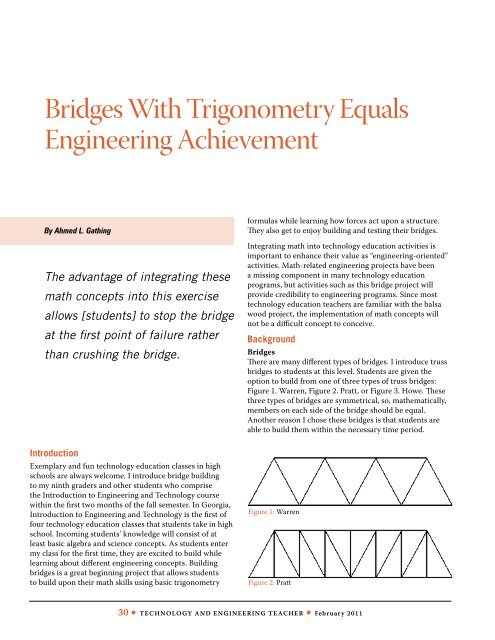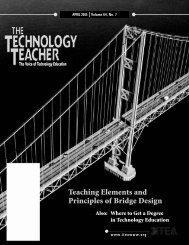K-12 Engineering Education Standards: - International Technology ...
K-12 Engineering Education Standards: - International Technology ...
K-12 Engineering Education Standards: - International Technology ...
Create successful ePaper yourself
Turn your PDF publications into a flip-book with our unique Google optimized e-Paper software.
Bridges With Trigonometry Equals<br />
<strong>Engineering</strong> Achievement<br />
By Ahmed L. Gathing<br />
The advantage of integrating these<br />
math concepts into this exercise<br />
allows [students] to stop the bridge<br />
at the first point of failure rather<br />
than crushing the bridge.<br />
Introduction<br />
Exemplary and fun technology education classes in high<br />
schools are always welcome. I introduce bridge building<br />
to my ninth graders and other students who comprise<br />
the Introduction to <strong>Engineering</strong> and <strong>Technology</strong> course<br />
within the first two months of the fall semester. In Georgia,<br />
Introduction to <strong>Engineering</strong> and <strong>Technology</strong> is the first of<br />
four technology education classes that students take in high<br />
school. Incoming students’ knowledge will consist of at<br />
least basic algebra and science concepts. As students enter<br />
my class for the first time, they are excited to build while<br />
learning about different engineering concepts. Building<br />
bridges is a great beginning project that allows students<br />
to build upon their math skills using basic trigonometry<br />
formulas while learning how forces act upon a structure.<br />
They also get to enjoy building and testing their bridges.<br />
Integrating math into technology education activities is<br />
important to enhance their value as “engineering-oriented”<br />
activities. Math-related engineering projects have been<br />
a missing component in many technology education<br />
programs, but activities such as this bridge project will<br />
provide credibility to engineering programs. Since most<br />
technology education teachers are familiar with the balsa<br />
wood project, the implementation of math concepts will<br />
not be a difficult concept to conceive.<br />
Background<br />
Bridges<br />
There are many different types of bridges. I introduce truss<br />
bridges to students at this level. Students are given the<br />
option to build from one of three types of truss bridges:<br />
Figure 1. Warren, Figure 2. Pratt, or Figure 3. Howe. These<br />
three types of bridges are symmetrical, so, mathematically,<br />
members on each side of the bridge should be equal.<br />
Another reason I chose these bridges is that students are<br />
able to build them within the necessary time period.<br />
Figure 1: Warren<br />
Figure 2: Pratt<br />
30 • <strong>Technology</strong> and <strong>Engineering</strong> Teacher • February 2011
















